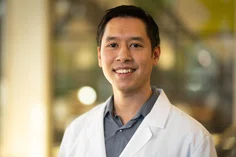


result

Feature Story
Prioritizing In-office Compounding to Put Patients First
Prioritizing In-office Compounding to Put Patients First
These two practices have put in the work to better serve their patients

Andrew T. Dang, MD, FAAAAI, in his practice
Within the intricate landscape of allergen immunotherapy, in-office compounding is as much an art as it is a science, according to Andrew T. Dang, MD, FAAAAI, who recently made key investments in his practice to comply with the new compounding requirements.

Andrew T. Dang, MD, FAAAAI
“I think of a chef making a dish for a customer ‘in-kitchen’ analogous to the allergist making immunotherapy ‘in-office’ very well,” he said. “The chef has an individualized approach to the recipe that should be unique to their customer so they have the best experience, and this best experience is maximized by the chef maintaining control of producing the dish ‘in-kitchen’ instead of outsourcing the recipe. “
“Allergen immunotherapy is a unique treatment that is created through a shared decision-making process between a provider and a patient,” Dr. Dang added. “In-office compounding allows the treatment to be as individualized as possible.”
Shahab Virani, MD, echoed a similar sentiment. “In-office compounding allows allergists to have the necessary quality control. If you know where the extract is coming from you can better guarantee promising results. As allergists, this is something we do frequently, and we are the most qualified to do it correctly to help and protect our patients.”
That personalized approach to allergen immunotherapy is why so many allergist/immunologists have made the efforts to adhere to the newly implemented USP Chapter 797 Standards for Sterile Compounding. The guidelines address compounding personnel training and evaluation, hygiene and garbing, updated documentation requirements, plus either installation of an ISO Class 5, Primary Engineering Control (often referred to as a hood) or establishment of a Dedicated Allergenic Extracts Compounding Area.

Shahab Virani, MD
Dr. Virani works at a small private practice with four allergists. When asked about the difficulties of implementing changes for USP 797, he said, “the biggest challenge we faced was choosing which route to pursue when it came to following the guidelines. Did we want a compound area, or to invest in a hood? The two pathways lead to different structures, and either of them can be resource draining if you don’t have the means to make the changes. We’re fortunate to have a wonderful team that worked together to make the changes necessary.”
Dr. Dang opted to invest in an ISO 5 certified hood. “One of our nurse leaders reached out to various vendors and narrowed down our options to two vendors who we are still in active negotiations with to finalize a purchase and install for the certified hood,” he said.
He also spent time revising the standard operating procedures to account for appropriate garbing/aseptic technique, as well as establishing a protocol for certification of personnel involved with vial mixing to meet USP 797 guidelines. “We are planning on initially training myself as well as three other staff members for USP 797 standards — this number is based on the number of physical clinics we operate, number of patients that our business sees and the logistics of how our clinics are managed with regards to immunotherapy vial stock and supplies,” he said.
All the effort is well worth it, according to Dr. Dang. He pointed out how outsourcing immunotherapy introduces several variables that could impact treatment, including:
- More difficulty in maintaining and adapting to the unique characteristics and needs of each patient
- Increased chance for “supply chain” issues such as delay in delivery or vials lost in transport
- Having to deal with and incorporate another set of staffing in terms of separate work hours/work days and holiday schedules, superimposed with the primary clinic’s staffing/schedules.
For those interested in doing in-office compounding, Dr. Virani has some advice. “Reach out to other allergists to understand what the challenges are and how to overcome them. We are a small community that’s open to learning together. Refer to your local societies and national organizations like the AAAAI to get the resources you need to get started. And never be afraid to have questions - you can always reach out to colleagues or the AAAAI Advocacy Committee for help!”
If you’re looking for more information and resources, the AAAAI’s Compounding Corner is here to help, and you can always reach out to practicemanagement@aaaai.org with questions.





